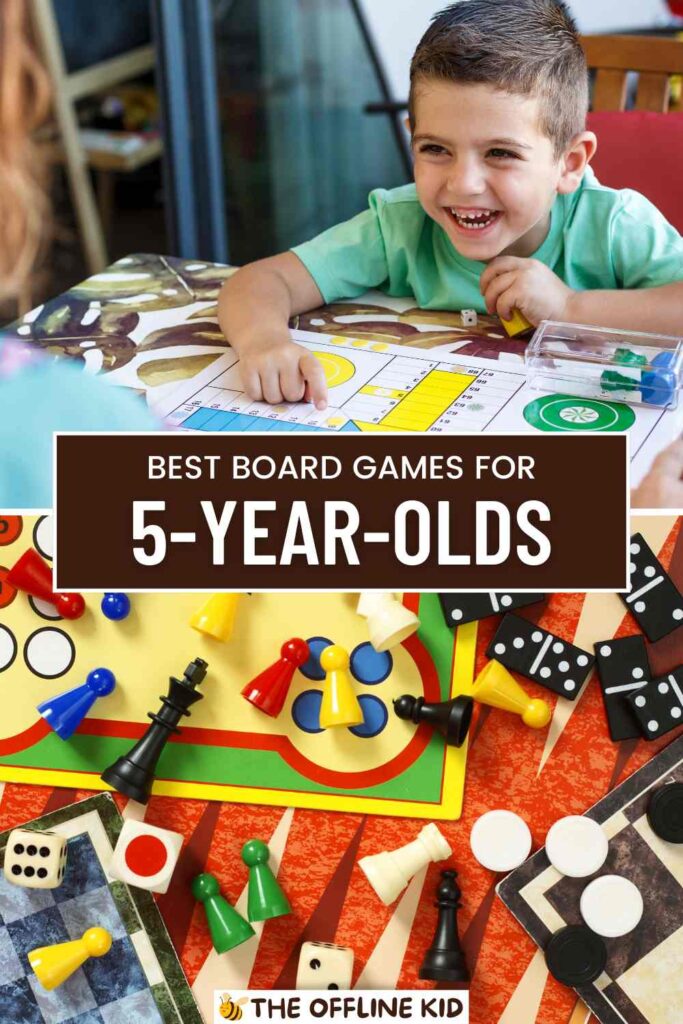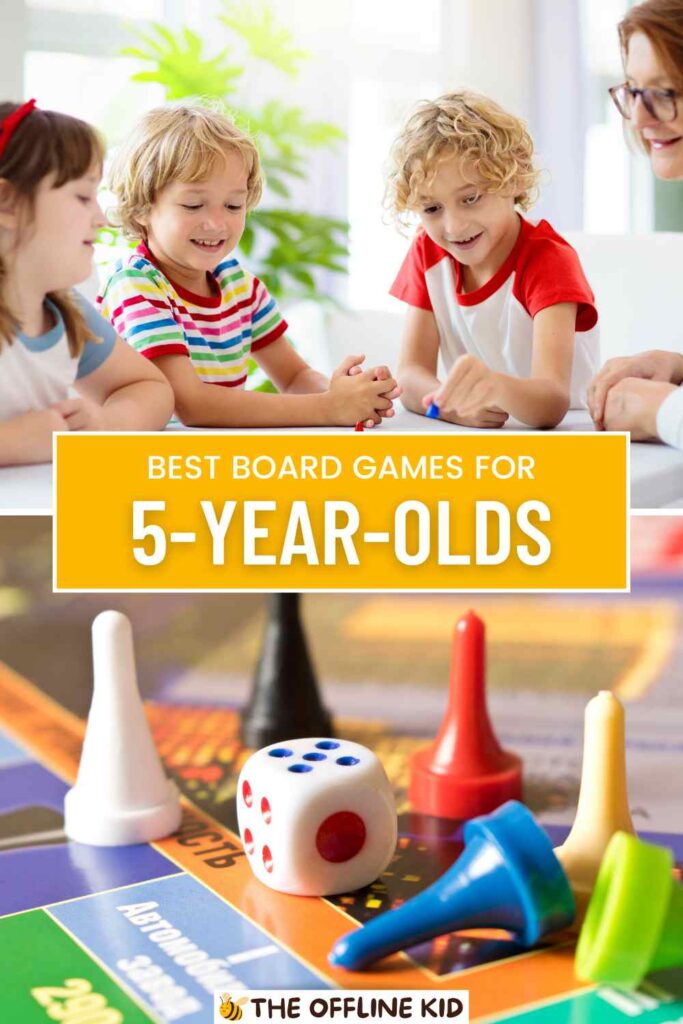Board games are a fantastic way to boost a child’s cognitive and social skills while having fun.
This guide explores over 25 of the best board games for 5-year-olds, ensuring endless hours of entertainment and learning.
Choosing the Right Board Game
Choosing the right board game for your 5-year-old can be a delightful yet challenging task.
With so many options available, it’s essential to select games that are age-appropriate, engaging, and educational. Here are some key factors and tips to help you make the best choice:
Factors to Consider
- Age Appropriateness
- Ensure the game is suitable for 5-year-olds. Check the age recommendation on the box.
- Look for simple rules and straightforward gameplay.
- Skill Level and Complexity
- Choose games that match your child’s developmental stage.
- Avoid games that are too challenging or too simple.
- Educational Value
- Opt for games that enhance cognitive skills, such as counting, matching, and problem-solving.
- Consider games that teach social skills like taking turns, cooperation, and patience.
- Fun Factor and Engagement
- Select games that your child finds enjoyable and exciting.
- Look for vibrant colors, appealing themes, and interactive elements.
- Safety and Durability
- Ensure the game pieces are safe and non-toxic.
- Choose sturdy and durable games that can withstand rough play.
Tips for Parents
- Involve Your Child in the Selection Process
- Let your child help choose the game. This increases their interest and excitement.
- Discuss their preferences and interests to find a game they’ll love.
- Balance Educational Content and Fun
- While educational games are beneficial, ensure they are also entertaining.
- Strike a balance between learning and play to keep your child engaged.
By considering these factors and tips, you can select the perfect board game that will provide both fun and educational benefits for your 5-year-old. Now, let’s dive into our top recommendations!
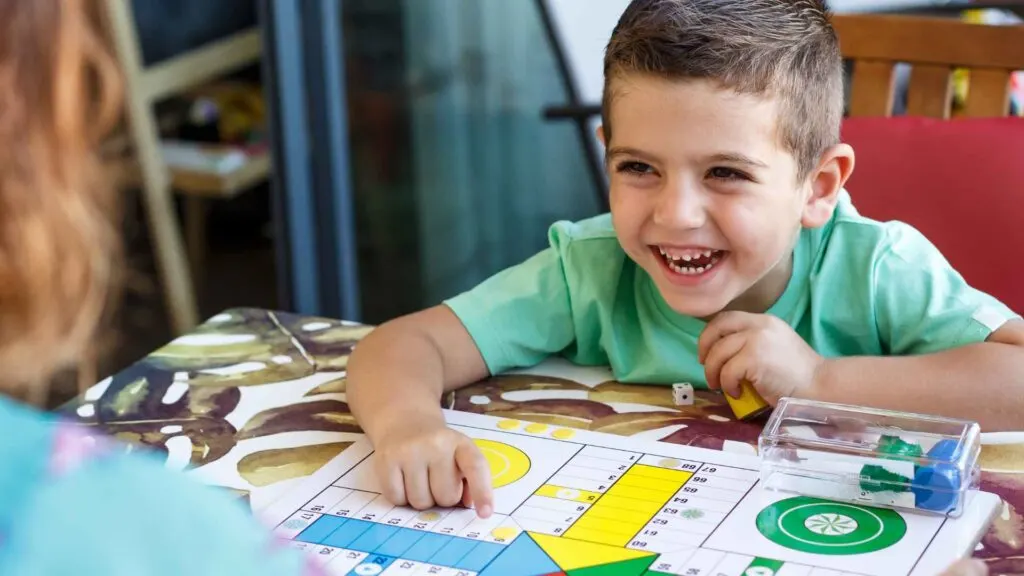
Educational Games
Educational games are a fantastic way to combine learning with play. They help children develop essential skills such as counting, matching, memory, and more.
Here are some top educational board games for 5-year-olds:
Candy Land
- Description and Gameplay
- Candy Land is a classic game where players race to the Candy Castle by drawing colorful cards and moving their pieces along the path.
- The game is simple, with no reading required, making it perfect for young children.
- Educational Benefits
- Colors: Helps children recognize and differentiate between colors.
- Counting: Encourages counting as they move their pieces.
- Turn-Taking: Teaches patience and taking turns.
Zingo!
- Description and Gameplay
- Zingo! is a fast-paced game that combines Bingo with a fun, matching twist. Players slide the Zinger to reveal tiles and match them to their cards.
- The first player to fill their card wins.
- Educational Benefits
- Language Skills: Enhances vocabulary and language recognition.
- Matching: Develops matching skills and memory.
- Social Skills: Promotes interaction and social play.
Count Your Chickens!
- Description and Gameplay
- In Count Your Chickens!, players work together to help Mother Hen collect her chicks and bring them back to the coop.
- The game is cooperative, meaning players win or lose together.
- Educational Benefits
- Counting: Reinforces counting skills as players count the chicks.
- Teamwork: Encourages cooperation and working together.
- Social Skills: Builds communication and collaborative skills.
Hoot Owl Hoot!
- Description and Gameplay
- Hoot Owl Hoot! is a cooperative game where players help owlets fly back to their nest before the sun rises.
- Players draw color cards to move the owlets closer to the nest.
- Educational Benefits
- Color Recognition: Helps with identifying and matching colors.
- Cooperation: Teaches the importance of teamwork and collective effort.
- Strategic Thinking: Encourages planning and decision-making.
The Sneaky, Snacky Squirrel Game
- Description and Gameplay
- In The Sneaky, Snacky Squirrel Game, players take turns spinning the spinner to collect acorns and fill their logs.
- The first player to collect all five colored acorns wins.
- Educational Benefits
- Fine Motor Skills: Develops hand-eye coordination and fine motor skills.
- Color Matching: Enhances color recognition and matching abilities.
- Turn-Taking: Reinforces the concept of taking turns.
These educational games not only provide hours of fun but also offer valuable learning experiences for young children. Next, let’s explore some cooperative games that teach teamwork and collaboration.
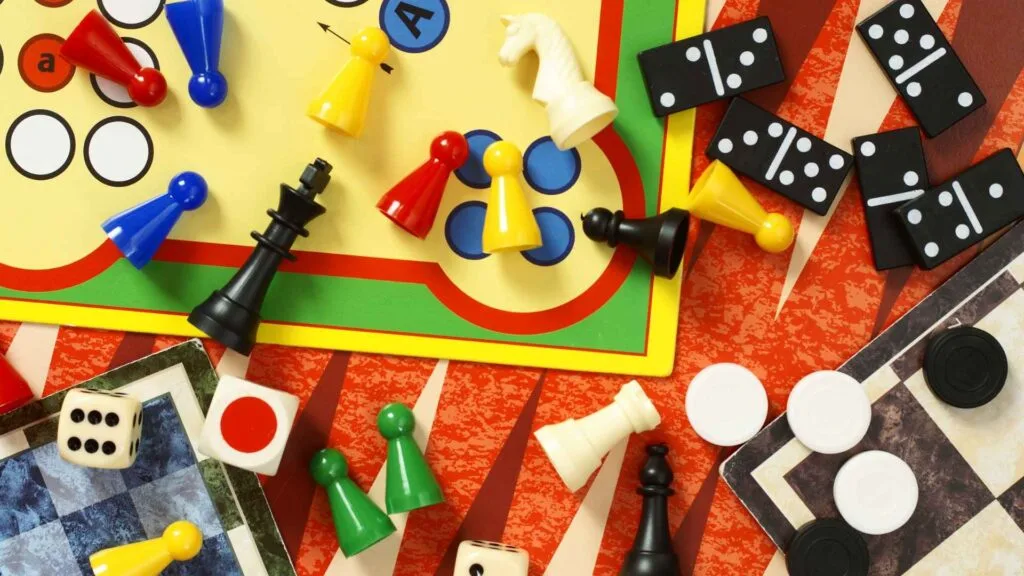
Cooperative Games
Cooperative games are perfect for teaching young children the value of teamwork, communication, and collective problem-solving.
In these games, players work together towards a common goal, which fosters a sense of unity and shared accomplishment. Here are some excellent cooperative board games for 5-year-olds:
Hoot Owl Hoot!
- Description and Gameplay
- Hoot Owl Hoot! is a delightful cooperative game where players help owlets fly back to their nest before the sun rises.
- Players draw color cards to move the owlets closer to the nest, strategizing together to ensure all owlets make it home in time.
- Cooperative Play Benefits
- Teamwork: Encourages players to collaborate and make decisions together.
- Color Recognition: Helps with identifying and matching colors.
- Strategic Thinking: Promotes planning and foresight.
Race to the Treasure!
- Description and Gameplay
- In Race to the Treasure!, players work together to create a path and collect keys before the Ogre reaches the treasure.
- The game involves drawing cards to build a path and strategizing to beat the Ogre.
- Cooperative Play Benefits
- Problem-Solving: Enhances critical thinking and problem-solving skills.
- Teamwork: Fosters a sense of unity and shared goal achievement.
- Strategic Planning: Encourages planning and foresight.
The Sneaky, Snacky Squirrel Game
- Description and Gameplay
- In The Sneaky, Snacky Squirrel Game, players work together to help the squirrels collect acorns and fill their logs.
- The game involves spinning a spinner to determine actions and working together to collect acorns.
- Cooperative Play Benefits
- Fine Motor Skills: Develops hand-eye coordination and fine motor skills.
- Color Matching: Enhances color recognition and matching abilities.
- Turn-Taking: Reinforces the concept of taking turns and patience.
Count Your Chickens!
- Description and Gameplay
- In Count Your Chickens!, players collaborate to help Mother Hen collect her chicks and bring them back to the coop.
- The game involves moving pieces based on spinner results and working together to gather all the chicks.
- Cooperative Play Benefits
- Counting Skills: Reinforces counting and number recognition.
- Teamwork: Teaches the importance of cooperation and collective effort.
- Social Skills: Builds communication and collaborative abilities.
Outfoxed!
- Description and Gameplay
- Outfoxed! is a cooperative whodunit game where players work together to find clues and deduce which fox stole the pot pie.
- The game involves rolling dice, uncovering clues, and working together to solve the mystery.
- Cooperative Play Benefits
- Deductive Reasoning: Enhances logical thinking and deduction skills.
- Teamwork: Encourages collaborative problem-solving and decision-making.
- Observation Skills: Develops keen observation and attention to detail.
These cooperative games provide a fun and engaging way for children to learn the value of working together towards a common goal. Up next, let’s delve into some classic board games that have stood the test of time.
Classic Board Games
Classic board games have been beloved by generations for a reason. They offer timeless fun and simple gameplay that is perfect for young children.
Here are some classic board games that are ideal for 5-year-olds:
Chutes and Ladders
- Description and Gameplay
- Chutes and Ladders is a straightforward game where players move their pieces along a numbered board, climbing ladders and sliding down chutes.
- The objective is to reach the final square first by spinning the spinner and moving the corresponding number of spaces.
- Timeless Appeal and Educational Value
- Counting: Helps children practice counting and number recognition.
- Turn-Taking: Reinforces the concept of taking turns.
- Patience and Sportsmanship: Teaches children to handle ups and downs gracefully.
Hi Ho! Cherry-O
- Description and Gameplay
- Hi Ho! Cherry-O is a simple game where players spin a spinner to collect cherries, blueberries, apples, and oranges from their trees and place them in their baskets.
- The first player to fill their basket with 10 pieces of fruit wins.
- Counting and Fine Motor Skills
- Counting: Encourages counting and number recognition.
- Fine Motor Skills: Develops hand-eye coordination as children pick up and place fruit pieces.
- Turn-Taking: Reinforces the concept of taking turns and patience.
Guess Who?
- Description and Gameplay
- Guess Who? is a two-player game where each player selects a mystery character and takes turns asking yes-or-no questions to deduce the other player’s character.
- The objective is to be the first to guess the opponent’s character correctly.
- Deductive Reasoning and Observation Skills
- Deductive Reasoning: Enhances logical thinking and deduction skills.
- Observation Skills: Develops keen observation and attention to detail.
- Questioning: Encourages strategic questioning and critical thinking.
Candy Land
- Description and Gameplay
- Candy Land is a colorful, straightforward game where players draw cards to move their pieces along a path to the Candy Castle.
- The game involves no reading, making it perfect for young children.
- Educational Value
- Colors: Helps children recognize and differentiate between colors.
- Counting: Encourages counting as they move their pieces.
- Turn-Taking: Teaches patience and taking turns.
Connect 4
- Description and Gameplay
- Connect 4 is a two-player game where players take turns dropping colored discs into a vertical grid, aiming to connect four of their discs in a row, either horizontally, vertically, or diagonally.
- The first player to connect four discs wins.
- Strategic Thinking and Pattern Recognition
- Strategic Thinking: Encourages planning and foresight.
- Pattern Recognition: Develops the ability to recognize and anticipate patterns.
- Fine Motor Skills: Enhances hand-eye coordination and dexterity.
Operation
- Description and Gameplay
- Operation is a fun game where players use tweezers to remove various ailments from a patient without touching the edges and setting off the buzzer.
- The player who successfully removes the most ailments wins.
- Hand-Eye Coordination and Concentration
- Fine Motor Skills: Develops hand-eye coordination and precision.
- Concentration: Enhances focus and attention to detail.
- Patience: Teaches children to be careful and deliberate in their actions.
These classic board games provide endless hours of entertainment while teaching valuable skills. They are perfect for family game nights and will be cherished by your 5-year-old for years to come. Next, let’s explore some strategy and problem-solving games that challenge young minds.
Strategy and Problem-Solving Games
Strategy and problem-solving games are excellent for developing critical thinking, planning, and decision-making skills in young children.
Here are some top strategy and problem-solving games for 5-year-olds:
Robot Turtles
- Description and Gameplay
- Robot Turtles is a coding board game where players write programs with playing cards to direct their turtle through a maze to reach a jewel.
- The game is designed to introduce young children to the basic concepts of coding.
- Introduction to Coding Concepts
- Programming Skills: Introduces the basics of coding and programming logic.
- Problem-Solving: Encourages critical thinking and problem-solving.
- Sequential Thinking: Develops the ability to plan and execute a sequence of actions.
Outfoxed!
- Description and Gameplay
- Outfoxed! is a cooperative whodunit game where players work together to gather clues and deduce which fox stole the pot pie.
- Players roll dice, reveal clues, and use deduction to identify the culprit before the fox escapes.
- Problem-Solving and Deductive Reasoning
- Deductive Reasoning: Enhances logical thinking and deduction skills.
- Teamwork: Encourages collaborative problem-solving and decision-making.
- Observation Skills: Develops keen observation and attention to detail.
Pengoloo
- Description and Gameplay
- Pengoloo is a memory and matching game where players roll dice to find hidden eggs under penguins. The goal is to collect six penguins with eggs.
- The game involves remembering the locations of different colored eggs.
- Memory and Strategy
- Memory Skills: Improves memory and recall abilities.
- Color Recognition: Enhances color recognition and matching skills.
- Strategic Thinking: Encourages planning and strategic decision-making.
Gnomes at Night
- Description and Gameplay
- Gnomes at Night is a cooperative maze game where players work together to move magnetic gnomes through a maze to collect treasures.
- The game involves communication and strategy to navigate the maze successfully.
- Cooperation and Communication
- Teamwork: Promotes cooperation and teamwork.
- Communication Skills: Develops effective communication and listening skills.
- Problem-Solving: Encourages strategic thinking and problem-solving.
Bugs in the Kitchen
- Description and Gameplay
- Bugs in the Kitchen is a fast-paced game where players use utensils to guide a battery-operated bug into a trap.
- The game involves quick thinking and strategic maneuvering.
- Quick Thinking and Coordination
- Hand-Eye Coordination: Develops fine motor skills and hand-eye coordination.
- Strategic Thinking: Encourages quick decision-making and strategy.
- Problem-Solving: Enhances problem-solving skills in a fast-paced environment.
Sneaky, Snacky Squirrel Game
- Description and Gameplay
- In The Sneaky, Snacky Squirrel Game, players take turns spinning the spinner to collect acorns and fill their logs.
- The first player to collect all five colored acorns wins.
- Fine Motor Skills and Strategy
- Fine Motor Skills: Develops hand-eye coordination and fine motor skills.
- Color Matching: Enhances color recognition and matching abilities.
- Turn-Taking: Reinforces the concept of taking turns and patience.
These strategy and problem-solving games are perfect for stimulating young minds and teaching essential cognitive skills.
They provide a fun and engaging way for children to develop their strategic thinking and problem-solving abilities. Up next, let’s look at some creative and imaginative play games that inspire creativity and storytelling.
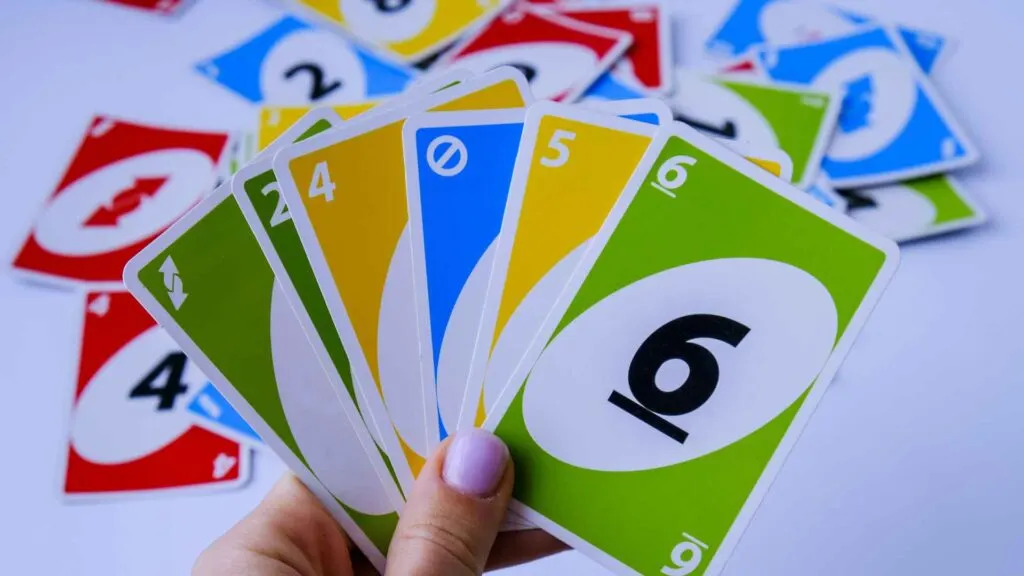
Creative and Imaginative Play Games
Creative and imaginative play games are fantastic for nurturing a child’s creativity, storytelling abilities, and imaginative thinking.
These games allow children to express themselves and explore their creativity in a fun and engaging way. Here are some excellent creative and imaginative play games for 5-year-olds:
Story Cubes
- Description and Gameplay
- Story Cubes is a storytelling game that involves rolling dice with different images and using them to create stories.
- Players take turns rolling the dice and crafting a story based on the images that appear.
- Encourages Storytelling and Imagination
- Creativity: Fosters imaginative thinking and creativity.
- Language Skills: Enhances vocabulary and language development.
- Social Skills: Promotes communication and social interaction.
Disney Eye Found It!
- Description and Gameplay
- Disney Eye Found It! is a hidden object game where players work together to find objects in various Disney-themed scenes.
- The game involves a large game board with detailed scenes and a spinner to move around the board.
- Observation and Cooperative Play
- Observation Skills: Develops keen observation and attention to detail.
- Cooperative Play: Encourages teamwork and collaboration.
- Fun and Engagement: Keeps children engaged with beloved Disney characters and scenes.
Gnomes at Night
- Description and Gameplay
- Gnomes at Night is a cooperative maze game where players work together to move magnetic gnomes through a maze to collect treasures.
- The game involves communication and strategy to navigate the maze successfully.
- Cooperation and Communication
- Teamwork: Promotes cooperation and teamwork.
- Communication Skills: Develops effective communication and listening skills.
- Problem-Solving: Encourages strategic thinking and problem-solving.
Animal Upon Animal
- Description and Gameplay
- Animal Upon Animal is a stacking game where players take turns stacking wooden animals on top of each other without letting them fall.
- The game involves balance, dexterity, and creativity.
- Balance and Dexterity
- Fine Motor Skills: Enhances hand-eye coordination and fine motor skills.
- Creativity: Encourages creative thinking in how animals are stacked.
- Patience: Teaches patience and careful planning.
Rory’s Story Cubes
- Description and Gameplay
- Rory’s Story Cubes is a creative game where players roll nine dice with different images and create a story using the images.
- The game is open-ended and encourages imaginative storytelling.
- Imaginative Storytelling
- Creativity: Fosters imaginative thinking and creativity.
- Language Development: Enhances vocabulary and language skills.
- Social Interaction: Promotes communication and social play.
Charades for Kids
- Description and Gameplay
- Charades for Kids is a simplified version of the classic game where players act out words or phrases without speaking, while others guess what it is.
- The game involves a variety of actions and themes that are easy for young children to understand.
- Acting and Imagination
- Imagination: Encourages creative thinking and imaginative play.
- Social Skills: Enhances communication and social interaction.
- Confidence: Builds confidence in expressing oneself through actions.
These creative and imaginative play games are perfect for inspiring a child’s creativity and storytelling abilities.
They provide endless opportunities for imaginative play and help develop important social and language skills. Up next, let’s explore some quick and easy games that are perfect for short play sessions.
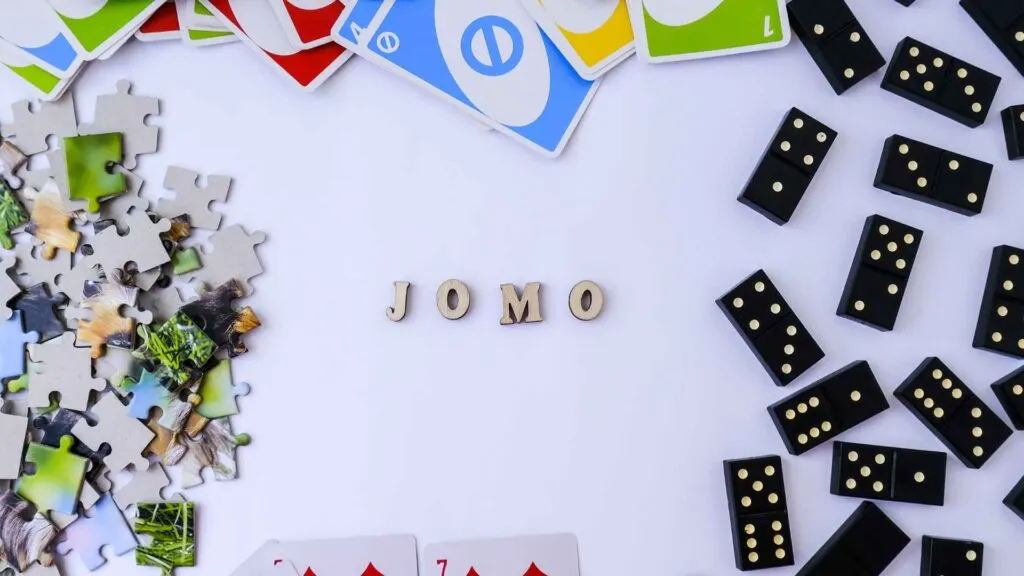
Quick and Easy Games
Quick and easy games are ideal for short play sessions and can be a great way to keep 5 year old children entertained without a significant time commitment.
These games are typically fast-paced and simple to understand, making them perfect for 5-year-olds. Here are some excellent quick and easy games:
Spot It!
- Description and Gameplay
- Spot It! is a fast-paced matching game where players try to find the matching symbol between two cards as quickly as possible.
- The game includes several mini-games, all focused on speed and observation.
- Quick Reflexes and Pattern Recognition
- Observation Skills: Enhances observation and quick thinking.
- Pattern Recognition: Develops the ability to recognize and match patterns.
- Social Interaction: Promotes friendly competition and social play.
Sushi Go!
- Description and Gameplay
- Sushi Go! is a card game where players draft cards to create the best sushi meal. Each round, players select a card to keep and pass the rest to the next player.
- The objective is to collect the highest-scoring combination of sushi dishes.
- Quick Decision Making and Strategy
- Strategic Thinking: Encourages planning and strategic decision-making.
- Quick Thinking: Develops the ability to make fast decisions.
- Math Skills: Helps with basic addition and scoring.
Loopin’ Louie
- Description and Gameplay
- Loopin’ Louie is a fun and fast-paced game where players use paddles to keep Louie, a flying character, from knocking down their chicken tokens.
- The game involves quick reflexes and coordination to protect your chickens.
- Fast-Paced Fun and Hand-Eye Coordination
- Hand-Eye Coordination: Enhances fine motor skills and hand-eye coordination.
- Reflexes: Develops quick reflexes and response times.
- Fun and Engagement: Keeps children engaged with fast-paced action.
Uno
- Description and Gameplay
- Uno is a classic card game where players try to be the first to get rid of all their cards by matching them to the discard pile by color or number.
- Special action cards add twists to the game, making it exciting and unpredictable.
- Color and Number Recognition
- Math Skills: Encourages basic counting and number recognition.
- Color Recognition: Helps with identifying and matching colors.
- Strategy: Develops strategic thinking and planning.
Sleeping Queens
- Description and Gameplay
- Sleeping Queens is a card game where players try to wake up queens from their slumber by using strategy and a bit of luck.
- The game involves drawing and playing cards to awaken as many queens as possible.
- Strategy and Memory
- Memory Skills: Enhances memory and recall abilities.
- Strategic Thinking: Encourages planning and strategic decision-making.
- Imagination: Adds a whimsical and imaginative element to play.
Rhino Hero
- Description and Gameplay
- Rhino Hero is a stacking game where players build a tower by adding walls and roof cards, trying not to topple the tower while moving the rhino figure up the structure.
- The game involves balance, dexterity, and a bit of luck.
- Balance and Dexterity
- Fine Motor Skills: Develops hand-eye coordination and fine motor skills.
- Patience and Care: Teaches patience and careful planning.
- Fun and Engagement: Keeps 5 year old children entertained with a playful theme.
These quick and easy games are perfect for short bursts of fun and can be played multiple times in one sitting.
They provide a great way to keep children entertained while developing essential skills. Next, let’s explore some outdoor board games that are perfect for active play.
Outdoor Board Games
Outdoor board games are a wonderful way to combine the excitement of board games with the benefits of physical activity.
These games are designed to be played outside, allowing children to enjoy fresh air and exercise while having fun. Here are some top outdoor board games for 5-year-olds:
Twister
- Description and Gameplay
- Twister is a classic game that involves placing hands and feet on colored circles on a mat according to the spinner’s instructions.
- The objective is to stay balanced and avoid falling while stretching to reach the designated spots.
- Physical Activity and Coordination
- Coordination: Enhances balance and coordination.
- Flexibility: Encourages stretching and physical movement.
- Social Interaction: Promotes laughter and friendly competition.
Giant Jenga
- Description and Gameplay
- Giant Jenga is an oversized version of the classic stacking game where players take turns removing wooden blocks from a tower and placing them on top without causing the tower to collapse.
- The game can be played individually or in teams.
- Motor Skills and Strategy
- Fine Motor Skills: Develops hand-eye coordination and dexterity.
- Strategic Thinking: Encourages planning and careful decision-making.
- Patience: Teaches patience and precision.
Cornhole
- Description and Gameplay
- Cornhole is a popular outdoor game where players take turns throwing bean bags at a raised platform with a hole in it. The goal is to get the bags into the hole or land them on the platform.
- The game can be played individually or in teams.
- Aiming and Coordination
- Hand-Eye Coordination: Enhances aiming and throwing skills.
- Gross Motor Skills: Develops large motor skills through physical activity.
- Social Play: Encourages teamwork and friendly competition.
Ladder Toss
- Description and Gameplay
- Ladder Toss, also known as Ladder Golf, involves throwing bolas (two balls connected by a string) onto a ladder structure with rungs of varying points.
- Players aim to land the bolas on the rungs to score points.
- Aiming and Precision
- Accuracy: Develops aiming and precision skills.
- Coordination: Enhances hand-eye coordination.
- Team Play: Promotes teamwork and social interaction.
Bean Bag Toss
- Description and Gameplay
- Bean Bag Toss is a simple game where players throw bean bags into holes on a board to score points. The game is similar to Cornhole but often designed for younger children with lighter bean bags and closer distances.
- It can be played individually or in teams.
- Gross Motor Skills and Coordination
- Hand-Eye Coordination: Improves aiming and throwing accuracy.
- Gross Motor Skills: Develops larger motor skills through active play.
- Social Interaction: Encourages friendly competition and team play.
Ring Toss
- Description and Gameplay
- Ring Toss involves throwing rings onto pegs or stakes to score points. The game can be set up in various configurations to increase difficulty.
- Players take turns aiming for the pegs to earn points.
- Aiming and Precision
- Accuracy: Develops aiming and precision skills.
- Coordination: Enhances hand-eye coordination.
- Active Play: Encourages physical activity and outdoor fun.
These outdoor board games are perfect for combining physical activity with fun gameplay, making them ideal for energetic 5-year-olds.
They provide a great way to enjoy the outdoors while developing important motor skills and coordination. Up next, let’s explore some tips for playing board games with 5-year-olds.
Tips for Playing Board Games with 5-Year-Olds
Playing board games with young 5-year-old children can be a fun and enriching experience for the whole family.
However, it’s important to create a positive and engaging environment to ensure everyone enjoys the game. Here are some tips for playing board games with 5-year-olds:
Creating a Positive Gaming Environment
- Comfortable Play Area
- Set up a clean and comfortable space with enough room for all players.
- Ensure the area is well-lit and free from distractions.
- Organized Game Components
- Keep game pieces organized and within easy reach.
- Use containers or bags to store small pieces and avoid losing them.
- Clear Instructions
- Explain the game rules clearly and simply, using age-appropriate language.
- Demonstrate how to play if needed, and be patient with questions.
Encouraging Good Sportsmanship
- Winning and Losing Gracefully
- Teach children to celebrate wins modestly and handle losses gracefully.
- Emphasize that the fun of playing together is more important than the outcome.
- Praising Effort
- Praise children for their effort and participation, not just for winning.
- Acknowledge good moves and creative strategies, regardless of the result.
- Turn-Taking and Patience
- Reinforce the importance of taking turns and waiting patiently.
- Use a timer or visual cues to help children understand turn-taking.
Adapting Games for Different Skill Levels
- Simplifying Rules
- Simplify complex rules to make the game more accessible for younger children.
- Gradually introduce more challenging aspects of the game as children become more comfortable.
- Assisting When Needed
- Offer help and guidance without taking over the game.
- Encourage children to think through their moves and offer gentle suggestions.
- Introducing New Games Gradually
- Start with simpler games and gradually introduce more complex ones.
- Ensure children are comfortable with the basics before moving on to more challenging games.
Keeping Children Engaged
- Short Play Sessions
- Keep play sessions short and sweet to maintain attention and interest.
- Play multiple shorter games rather than one long game if needed.
- Making It Fun
- Use enthusiastic language and positive reinforcement to keep the game exciting.
- Incorporate silly voices, dramatic storytelling, or fun challenges to enhance engagement.
- Involving the Whole Family
- Encourage family members to join in, making the game a social and inclusive activity.
- Rotate who chooses the game to ensure everyone gets a turn to play their favorite.
By following these tips, you can create a positive and enjoyable board game experience for your 5-year-old.
Playing games together not only provides fun and entertainment but also helps children develop important social and cognitive skills.
